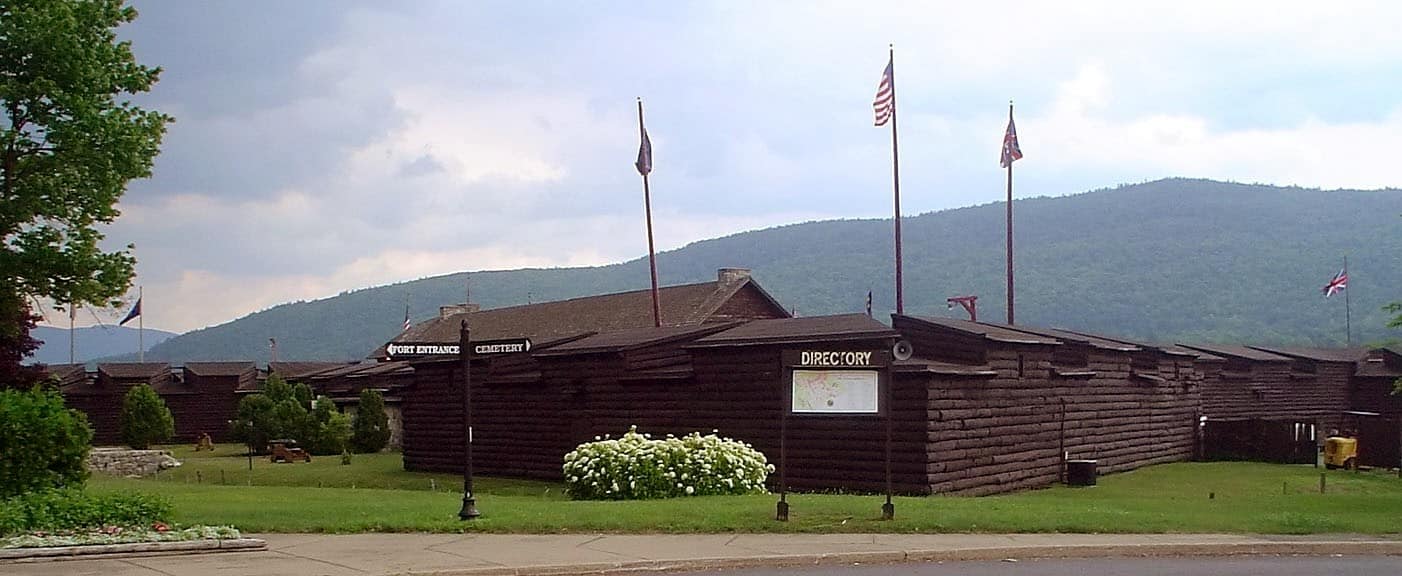
ADVERTISEMENT - CONTINUE READING BELOW
Fort William Henry, New York
Fort William Henry was built early in the French and Indian War, serving for a time as an advanced post on the New York frontier, guarding the approaches by water between the French fortress at Carillon, (later Ticonderoga) and Albany. William Henry served as the base of operations for the British ranging companies formed from colonial troops early in the war, and was a critical defense point against Indian raids striking south from Canada. In 1757 a French-Canadian Force, with supporting Indian raids, attacked the fort and placed it under siege. The French were led by General Louis Montcalm.
Fort William Henry withstood the siege for a time, believing a relief force was on its way from nearby Fort Edward. When it became evident that no relief was to be forthcoming its commander, British Major George Munro, accepted the generous surrender with honor terms offered by Montcalm, which allowed his troops to abandon the position but retain their arms and colors, with the promise that they would not further engage the French until they were properly exchanged. The British garrison abandoned the post and began a march to Fort Edward, under the protection of French guards.
Despite the presence of the guards the Indian allies of the French attacked the column in the open, determined to obtain scalps and military acclaim before the campaign came to an end. The event was described as the “Massacre of Fort William Henry” and was dramatized years later by James Fenimore Cooper in his novel The Last of the Mohicans. The Indians looted the fort, killing the prisoners left behind under the care of French surgeons, and dug up the graves in the fort’s cemetery in order to scalp the dead. About 200 British and Americans were killed outright by the Indians, who also exposed themselves to smallpox from the slaughtered prisoners and infected blankets.
ADVERTISEMENT - CONTINUE READING BELOW
Before the end of the year (the fort surrendered on August 8) American and British raids of retaliation were being launched against Indian villages and smallpox ravaged the tribes. The French destroyed the fort and withdrew to Carillon for the winter. The site remained abandoned for almost two centuries, though there was discussion of the place being haunted as early as the war of 1812, when American troops encamped on the site. The tourism industry and interest in the site led to a reconstructed fort being erected in the 1950s. Since its opening the site has conducted ghost tours.
There are reports to this day of ghostly sightings in the vicinity of the fort, on Rogers’ Island nearby (where Rogers’ Rangers camped while at the fort) and in several nearby dwellings and reconstructed farms. Many of these stories seem to have begun around the time that James Fenimore Cooper was writing his many stories and novels, and some descend from Mohawk and other Indian oral histories. Paranormal enthusiasts and those merely seeking entertainment are offered ghost tours covering the areas around the site, which has been reportedly haunted for more than two and a half centuries.
Where do we find this stuff? Here are our sources:
“Chattanooga Chills”, by Mark Fults, 2013
“Highlands is Scotland’s Most Haunted Area”, BBC News, November 17, 2011
“Haunted Road Leads to Ghosts and Murder”, by Rich Griset, Daily Press, October 2013
“Haunted Savannah: The Official Guidebook to Savannah Haunted History Tour”, by James Caskey, 2005
“Looking for Ghosts at Cold Harbor”, by Amy Condra, Richmond Times-Leader, May 13, 2008
“Exploring the Darker Side of Okinawa”, by Nicholas Kristof, The New York Times, January 21, 1996
“Ghost hunters go bump in the night”, by Lydia Wheeler, the Post Star (Glens Falls), April 17, 2010

